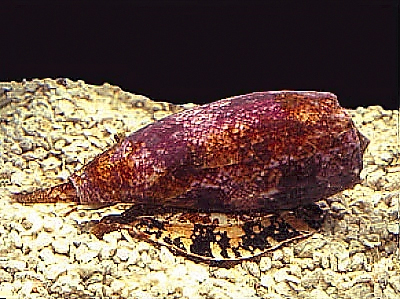Hitched a ride on a coral in the LFS. Region unknown. It's in the family of cone snails, color red. It's actually eating holes in my sponge and eating live astreas snails of equal size clean out of the shell. It's got a big appetite for a 1-1/2" snail. Venomous that shoots a spear from it's mouth or nose, told not to touch because it can turn and shoot it's stinger almost behind it's shell in defense. Quick mover. Currently feeding it frozen brine shrimp. This thing will really clean a tank. Most of my snails are up on the glass safely away, so it's the shrimps I'm worried about.... and my fingers! This snail doesn't like to climb the glass since it hunts for food on the bottom.
Debating keeping it or giving it to the fish store. I'm worried it will eat my cleaner shrimps as they investigate. Right now I have the snail separated since it's been carnivorous.
What do you think. Will my cleaner shrimps become a meal? Shrimps are 4x larger right now. But this cone will be growing fast. Maybe too dangerous to have in my tank all together because of accidental sting to me maybe? My girlfriend picked it up unknowing it could sting. Just hid inside it's shell and made no effort to sting.
It pushes around a sponge coral as shelter to get to it's food, leaves the sponge grabs it's food, returns to the sponge and pushes the sponge back. Right now it's sleeping (or feeding on it) buried like a tick deep in the sponge.
But totally cool snail. Advice?
Debating keeping it or giving it to the fish store. I'm worried it will eat my cleaner shrimps as they investigate. Right now I have the snail separated since it's been carnivorous.
What do you think. Will my cleaner shrimps become a meal? Shrimps are 4x larger right now. But this cone will be growing fast. Maybe too dangerous to have in my tank all together because of accidental sting to me maybe? My girlfriend picked it up unknowing it could sting. Just hid inside it's shell and made no effort to sting.
It pushes around a sponge coral as shelter to get to it's food, leaves the sponge grabs it's food, returns to the sponge and pushes the sponge back. Right now it's sleeping (or feeding on it) buried like a tick deep in the sponge.
But totally cool snail. Advice?



